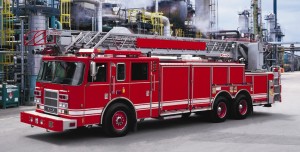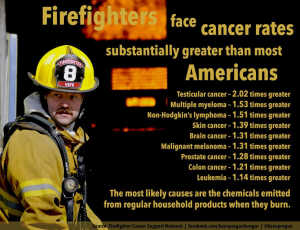By: Robert Avsec, Executive Fire Officer
Protecting firefighters and officers from respiratory exposures to toxic smoke on the fire scene has been a growing concern in the fire service for many years, and with good reason. The body of knowledge in this area continues to grow and undergo better validation processes to ensure that we are being provided scientifically sound information about the hazards and how to properly protect ourselves from those hazards.
An emerging area of related study is on the topic of firefighters and officers being exposed to the  gases and particulate matter from a source that’s found in every fire station around the world: the diesel-powered fire apparatus out in the apparatus bay. The exhaust from diesel engines contains a mixture of gases and very small particles that can create a health hazard when not properly controlled.
gases and particulate matter from a source that’s found in every fire station around the world: the diesel-powered fire apparatus out in the apparatus bay. The exhaust from diesel engines contains a mixture of gases and very small particles that can create a health hazard when not properly controlled.
 Beginning in 1994, Environmental Protection Agency (EPA) started strengthening emission limits for diesel engine exhaust; similar decreases continued in 1998, 2004 and 2007, with the final goal being reached in 2010. NOx is a generic term for mono-nitrogen oxides NO and NO2 (nitric oxide and nitrogen dioxide). They are produced from the reaction of nitrogen and oxygen gases in the air during combustion.
Beginning in 1994, Environmental Protection Agency (EPA) started strengthening emission limits for diesel engine exhaust; similar decreases continued in 1998, 2004 and 2007, with the final goal being reached in 2010. NOx is a generic term for mono-nitrogen oxides NO and NO2 (nitric oxide and nitrogen dioxide). They are produced from the reaction of nitrogen and oxygen gases in the air during combustion.
The majority of original equipment manufacturers (OEMs) of diesel engines have met the challenges associated with reducing NOx emissions. In 2007, however, the EPA rolled out new requirements calling for a 90 percent reduction in the soot contained in diesel exhaust emissions.
What is Diesel Particulate Matter (DPM)?
DPM is a component of diesel exhaust (DE) that includes soot particles made up primarily of carbon, ash, metallic abrasion particles, sulfates and silicates. Diesel soot particles have a solid core consisting of elemental carbon, with other substances attached to the surface, including organic carbon compounds known as aromatic hydrocarbons.
How are firefighters exposed to DE/DPM?
 Firefighters are at a high risk for exposure to DE/DPM because of the frequency with which they operate in close proximity to fire apparatus. Whether it’s operating at the scene of an emergency, or conducting routine apparatus maintenance on the ramp in front of the station, firefighters are working in relatively close proximity to the apparatus and its engine exhaust.
Firefighters are at a high risk for exposure to DE/DPM because of the frequency with which they operate in close proximity to fire apparatus. Whether it’s operating at the scene of an emergency, or conducting routine apparatus maintenance on the ramp in front of the station, firefighters are working in relatively close proximity to the apparatus and its engine exhaust.
Not only are they breathing DE/DPM, they are being exposed to skin absorption hazard as DE/DPM collects on their skin and clothing. According to Vampire Facial Los Angeles, this exposure can be particularly acute during hot weather when firefighters will be wearing lighter clothing, getting out of their turnout gear quickly, and perspiring profusely.
What are the health effects of DE/DPM?
Short term exposure to high concentrations of DE/DPM can cause headache, dizziness, and irritation of the eye, nose and throat severe enough to distract or disable firefighters. Prolonged DE/DPM exposure can increase the risk of cardiovascular, cardiopulmonary and respiratory disease and lung cancer. In June, 2012, the International Agency for Cancer Research (IARC) classified DE (including DPM) as a known human carcinogen (Group 1).
How can exposures to DE/DPM be controlled?
Engineering controls are the most effective strategy for minimizing worker exposure to DE/DPM. A combination of controls is often required. Examples include:
- Performing routine preventive maintenance of diesel engines to minimize emissions;
- Installing engine exhaust filters;
- Installing cleaner burning engines;
- Installing diesel oxidation catalysts;
- Using special fuels or fuel additives (e.g., biodiesel); and
- Installing or upgrading main or auxiliary ventilation systems, such as tailpipe or stack exhaust vents to capture and remove emissions in maintenance shops or other indoor locations.
In an article published on FireRescue1.com, I wrote on the subject of diesel emissions controls allegedly disabling fire apparatus. Turns out the far larger problem is that too many firefighters and officers don’t understand how the modern diesel emissions control equipment on their fire apparatus works, particularly the diesel particulate filter (DPF). Nor do they understand their role in keeping the system functioning at peak efficiency. Consult the manufacturers recommendations for you apparatus for the proper care and maintenance of the DFP on your truck.
Emerging Technology to Reduce Diesel Emissions
 Many departments are looking for effective and efficient ways to lessen the amount of emissions produced by the apparatus. Idle reduction technology (IRT) is another emerging technology that can significantly reduce the diesel emissions from fire apparatus by reducing the amount of time that the main diesel motor is operating at an idle speed. Idling fire apparatus cost money in several ways.
Many departments are looking for effective and efficient ways to lessen the amount of emissions produced by the apparatus. Idle reduction technology (IRT) is another emerging technology that can significantly reduce the diesel emissions from fire apparatus by reducing the amount of time that the main diesel motor is operating at an idle speed. Idling fire apparatus cost money in several ways.
First more fuel is burned. Second, nitrogen oxide is released in diesel emissions — while the APU does not alter the chemical make-up of emissions, it does reduce the amount of nitrogen oxides released.
Last, idling engines result in lower exhaust stream temperatures. The diesel particulate filter for the main diesel motor on today’s fire apparatus captures unspent diesel soot that occurs when the engine operates at cooler temperatures. Thus, more idling results in more frequent service intervals for the filters.
IRT, such as Rosenbauer’s Green Star IRT will reduce idle time through the use of an auxiliary power  unit (APU) in conjunction with automatic diesel engine controls that will shut down the main chassis diesel engine during operations not requiring the use of the pump assembly. The system is automated and does not require intervention from the vehicle operator. The IRT is only available when the chassis air brake is set and when the pump assembly is not engaged.
unit (APU) in conjunction with automatic diesel engine controls that will shut down the main chassis diesel engine during operations not requiring the use of the pump assembly. The system is automated and does not require intervention from the vehicle operator. The IRT is only available when the chassis air brake is set and when the pump assembly is not engaged.
Firefighters and officers alike must take a more active role in protecting themselves from DE and DPM during all activities that bring them into close proximity of running fire apparatus. The diesel exhaust coming out of today’s diesel-powered fire apparatus is cleaner than it’s ever been before, but it still isn’t fit to breath—or wear.
Additional information
The links below can be used to access additional information regarding diesel regulations and technical information on control measures.
EPA’s National Clean Diesel Campaign
OSHA’s Safety and Health Topics page on diesel exhaust
OSHA’s partial list of chemicals found in diesel exhaust
References
Avsec, R. Is emission control disabling fire trucks? FireRescue1. http://www.firerescue1.com/fire-products/fire-apparatus/articles/1461989-Is-emission-control-disabling-fire-trucks/
Avsec, R. 5 Game Changing Fire Truck Technologies. FireRescue1. http://www.firerescue1.com/fire-products/fire-apparatus/articles/1939464-5-game-changing-fire-truck-technologies/
EPA. National Clean Diesel Campaign. http://www.epa.gov/cleandiesel/index.htm
OSHA. Diesel Exhaust Hazard Alert. https://www.osha.gov/dts/hazardalerts/diesel_exhaust_hazard_alert.html
 Fire & EMS Leader Pro The job of old firefighters is to teach young firefighters how to become old firefighters!
Fire & EMS Leader Pro The job of old firefighters is to teach young firefighters how to become old firefighters!